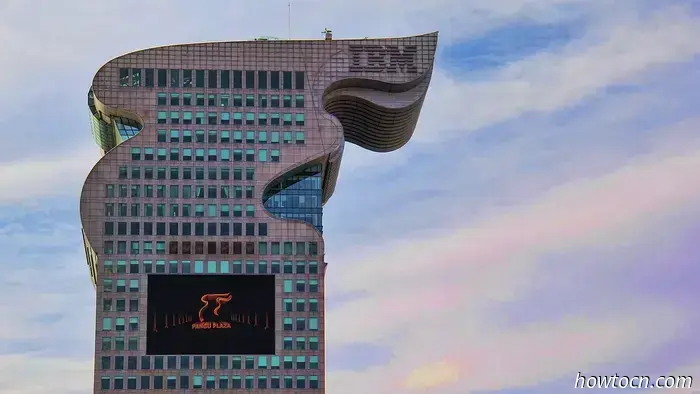
Beijing is rich in architectural wonders. The Bird's Nest, the Temple of Heaven, and even the latest subway systems possess their own sleek and minimalist appeal. Yet, prominently displayed and looming over highways and nestled within residential areas, there exists a different kind of urban phenomenon: Beijing's delightfully unattractive structures.
You’ve seen them. You’ve probably scoffed at them. Yet, beneath it all, you might find a hint of affection for them. Perhaps it’s nostalgia, or maybe it's a touch of Stockholm Syndrome. Whatever the case, these architectural oddities reveal more about Beijing than any guide could ever convey.
Let's start with a notable example. Pangu Plaza (盘古大观 Pángǔ Dàguān), situated just north of the Bird's Nest on Beichen Xilu, was designed by C.Y. Lee, the architect of Taipei 101. This dragon-shaped giant was intended to symbolize a crouching dragon bestowing good fortune upon the Olympic area. However, interpretations of its appearance vary. Some liken it to a toaster oven, while others see it as a Pokémon mid-evolution.
Pangu Plaza is a structure that evokes strong reactions. Whether it's awe, confusion, or a slight sense of unease, all feelings are valid. For locals, it is also a familiar sight. It embodies that 2000s spirit of “China can do anything,” solidified in concrete and glass, featuring an unoccupied hotel, empty office spaces, and a feng shui debate so notorious that it supposedly cursed nearby enterprises.
Nevertheless, the disputed design may have been too much to bear, leading to a partial demolition of Pangu Plaza in 2021 that removed its iconic "dragon head," an action that many viewed as the symbolic decapitation of a long-criticized structure. Reopening in 2023, some welcomed the change, viewing it as a solution to an architectural eyesore that has been labeled among China's "Top Ten Ugliest Buildings." Others mourned its removal, arguing that its striking form had evolved into a landmark in its own right.
In Datunli, Chaoyang District, lies Jinquanshidai Plaza (金泉时代广场 Jīnquán Shídài Guǎngchǎng), a building that refuses to conform or fade into the background. With its clashing colors, excessive adornments, and chaotic shapes, it evokes a sense of a runaway PowerPoint presentation turned skyscraper. Its crown, resembling a glossy spaceship perched atop a lavish wedding cake, and its facade presenting every texture imaginable except modesty, defy easy categorization. Is it an office tower? A mall? A monument to a bygone Y2K fantasy? It's hard to determine.
Constructed in the early 2000s, Jinquanshidai stands as a representation of a transitional period in Beijing's urban development—when boldness meant being bigger, louder, and shinier. It was a time of confidence, unlimited budgets, and a drive to outshine competitors. Today, the building serves as both a relic and a curiosity, illustrating the clash when ambition outstrips aesthetic sensibility.
To observers, it might feel like an assault on the senses. Yet, like many of Beijing's architectural curiosities, it possesses an unusual charm. It isn't beautiful. It isn't modest. But it is undeniably real— and unmistakably representative of Beijing.
Next is the embodiment of artificial fantasies: Shijingshan Amusement Park (石景山游乐园 Shíjǐngshān Yóulèyuán), located in the Shijingshan District to the west of the city. It's notorious for its unauthorized imitation castles, Disney-like mascots, and a carousel of copyright violations. However, its pink spires and mismatched towers extend beyond mere bad replicas; they serve as emotional remnants from a time when globalization hinged on bootlegging and optimistic mimicry.
On the west side of Chaoyang Park stands Junhao Central Park Plaza (骏豪中央公园广场 Jùnháo Zhōngyāng Gōngyuán Guǎngchǎng), often mistaken for an extraterrestrial embassy. With its sleek, dark curves and bug-like outline, the structure resembles less a plaza and more a craft that crash-landed from a more glamorous universe. Its shiny black exterior imparts the aura of a sci-fi villain quietly plotting in the city's heart. It doesn’t conform to its surroundings nor does it make any efforts to do so. Whether admired or despised, it cannot be overlooked. In Beijing, that in itself makes a statement.
These buildings are absurd, assertive, and a bit embarrassing. Yet, they are woven into Beijing's collective psyche. They reflect a generation nurtured in a climate of rapid urban growth, Olympic aspirations, and a strong belief that





Examining the charming grotesqueness of Beijing's most unusual and unattractive structures.